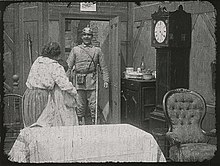The Joan of Arc of Loos
| The Joan of Arc of Loos | |
|---|---|
 | |
| Directed by | George Willoughby Martyn Keith ("stage manager")[1] |
| Written by | Herbert Ford[2] |
| Starring | Jane King |
| Cinematography | Franklyn Barrett |
Production company | Willoughby's Photo Plays[1] |
Release date | 5 April 1916 (preview)[1] |
Running time | 5,000 feet[3] |
| Country | Australia |
| Languages |
|
The Joan of Arc of Loos is a 1916 Australian silent film shot by Franklyn Barrett based on the true story of Émilienne Moreau-Evrard in World War I. Only a portion of the movie survives today.
Plot[edit]
The story is told in five acts.[4] In 1915, German troops led by Captain von Epstein capture the peaceful town of Loos and start committing atrocities on the local population. Von Epstein lusts after a young peasant girl, Émilienne Moreau (Jane King), but she escapes to the Allied lines. Inspired by the vision of Joan of Arc (Jean Robertson), she helps encourage the Allied troops in an attack to retake the town. She falls for a French dispatch rider (Clive Farnham) who is captured by the Germans and takes part in shooting German officers who are sniping on the Red Cross. Emilienne manages to engineer her lover's escape and winds up married to them. She is also awarded a military cross.[5][6]
Cast[edit]
- Jane King as Émilienne Moreau
- Jean Robertson as the angel
- Clive Farnham as soldier hero
- Beatrice Esmond
- Martyn Keith
- Arthur Greenaway
- Austin Milroy
- Harry Halley
- Winter Hall
- Irve Hayman
- Arthur Spence
- Fred Knowles
Production[edit]
The movie was the first film from theatre entrepreneur George Willoughby.[7]
The film was described as "one of the biggest picture undertakings yet attempted in Australia."[8] The village of Loos was recreated on Tamarama Beach in Sydney by scenic artist Jack Ricketts. The battle was staged with 300 extras including 100 returned servicemen. An avenue of poplars near Randwick Racecourse was used as a stand-in for the Flanders countryside.[9][10][11]
During production the film was known as Emilienne Moreau. Production was held up for a number of days when star Jean King collapsed after the filming of a scene "which necessitated very strenuous acting" and juvenile lead Clive Farnham was injured when a motorcycle he was driving during a scene skidded and threw him over a bridge.[12]
Reception[edit]
The movie was used as a recruitment tool[13] however it was not a success at the box office and reviews were poor.[14] Critics took particular exception to the story being old fashioned and suggesting the Battle of Loos was won by divine intervention rather than skill.[9] However Jean Robertson received positive notices for her performance as the angel.[15]
See also[edit]
References[edit]
- ^ a b c "AMUSEMENTS". The Sydney Morning Herald. National Library of Australia. 6 April 1916. p. 12. Retrieved 23 April 2012.
- ^ ""THE JOAN OF ARE OF LOOS"". The Sunday Times. Sydney: National Library of Australia. 9 April 1916. p. 7. Retrieved 10 December 2014.
- ^ "TRIUMPH PICTURES". Queanbeyan Age and Queanbeyan Observer. NSW: National Library of Australia. 25 August 1916. p. 2. Retrieved 23 April 2012.
- ^ "Advertising". Singleton Argus. NSW: National Library of Australia. 20 May 1916. p. 7. Retrieved 23 April 2012.
- ^ "JOHNSON'S PIOTURES". The Barrier Miner. Broken Hill, NSW: National Library of Australia. 25 July 1916. p. 3. Retrieved 23 April 2012.
- ^ "TOWN HALL PICTURES". The Advertiser. Adelaide: National Library of Australia. 12 February 1917. p. 9. Retrieved 23 April 2012.
- ^ "WILLOUGHBY PRODUCING PICTURFS". The Sunday Times. Sydney: National Library of Australia. 5 March 1916. p. 6. Retrieved 13 September 2014.
- ^ "WORLD OF RECREATION". The Worker. Brisbane: National Library of Australia. 16 March 1916. p. 12. Retrieved 13 September 2014.
- ^ a b Andrew Pike and Ross Cooper, Australian Film 1900–1977: A Guide to Feature Film Production, Melbourne: Oxford University Press, 1998, 63
- ^ "THE PICTURE SHOWS". The Winner. Melbourne: National Library of Australia. 15 March 1916. p. 12. Retrieved 10 December 2014.
- ^ "PRODUCTION OF MOVING PICTURES-- IN AMERICA AND AUSTRALIA". Australian Town and Country Journal. Vol. XCVIII, no. 2555. New South Wales, Australia. 18 December 1918. p. 20. Retrieved 21 November 2023 – via National Library of Australia.
- ^ "Australian Notes;" Moving Picture World (May 1916) at Internet Archive accessed 2o November 2014
- ^ "ENTERTAINMENTS". The West Australian. Perth: National Library of Australia. 12 June 1917. p. 6. Retrieved 23 April 2012.
- ^ Daniel Reynaud, 'The Effectiveness of Australian Film Propaganda for the War Effort 1914-1918', Screening the Past Archived 8 March 2011 at the Wayback Machine
- ^ "JEAN ROBERTSON". The Prahran Telegraph. Vic.: National Library of Australia. 8 July 1916. p. 8. Retrieved 23 April 2012.
